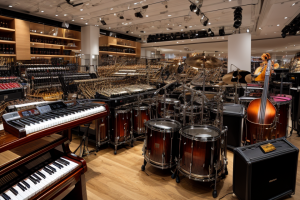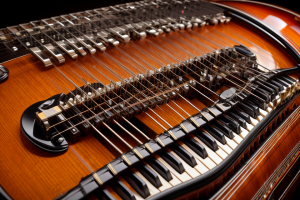
The musical instrument market has been undergoing a significant transformation over the past few years, with the advent of new technologies and changing consumer preferences. In 2023, the sales of musical instruments have continued to evolve, with a shift towards online purchases and an increasing demand for innovative and high-quality products. This article explores the current state of the musical instrument market, examining trends, challenges, and opportunities in the industry. We will delve into the factors driving sales, the impact of e-commerce, and the emergence of new players in the market. Join us as we take a closer look at the evolution of the musical instrument market in 2023.
The Growing Popularity of Musical Instruments
The Influence of Social Media
Social media has played a significant role in the growing popularity of musical instruments. Platforms such as Instagram, TikTok, and YouTube have become hubs for musicians, music enthusiasts, and influencers to share their content and engage with audiences. The rise of these platforms has created a new avenue for aspiring musicians to showcase their talent and gain recognition, which has contributed to the increase in demand for musical instruments.
Additionally, social media has also fueled the trend of cover songs and remixes, which has further increased the popularity of musical instruments. Many artists have gained popularity by performing covers of popular songs, which has led to an increase in the demand for instruments that can replicate the sounds of these songs. This has resulted in a surge in the sales of guitars, drum sets, and keyboards, among other instruments.
Moreover, social media has also created a new market for musical accessories and gear. Many musicians and music enthusiasts use social media to showcase their equipment and share their opinions on different products. This has led to an increase in the demand for musical accessories such as cables, pedals, and amplifiers, among others.
In conclusion, the influence of social media on the musical instrument market has been significant. It has created new opportunities for musicians to showcase their talent, contributed to the increase in demand for certain instruments, and fueled the trend of musical accessories and gear. As social media continues to grow and evolve, it is likely that its impact on the musical instrument market will continue to be significant.
The Impact of Online Learning Platforms
In recent years, the rise of online learning platforms has significantly impacted the musical instrument market. These platforms have made it easier for individuals to learn and play musical instruments, leading to an increase in demand for musical instruments.
One of the primary advantages of online learning platforms is their accessibility. With just an internet connection, users can access a wealth of information and resources, including tutorials, videos, and online courses. This has made it possible for people in remote areas or those with limited access to music schools and instructors to learn how to play musical instruments.
Furthermore, online learning platforms offer a flexible and convenient way to learn. Students can access the content at their own pace and from the comfort of their own homes. This has led to an increase in the number of people who are interested in learning to play musical instruments, even if they have busy schedules or other commitments.
Additionally, online learning platforms have created a community of like-minded individuals who share a passion for music. Through online forums and social media groups, users can connect with other learners and musicians, share tips and advice, and collaborate on musical projects. This sense of community has further fueled the popularity of musical instruments and the musical instrument market.
In conclusion, the rise of online learning platforms has played a significant role in the growing popularity of musical instruments. These platforms have made it easier for people to learn and play musical instruments, leading to an increase in demand for musical instruments.
Market Segmentation: Instruments and Genres
The Expansion of the Brass Section
In recent years, the brass section has experienced a significant expansion in the musical instrument market. This growth can be attributed to several factors, including increased interest in orchestral music, the rise of brass-centric genres such as jazz and funk, and advancements in instrument technology.
One of the primary drivers of this expansion is the growing popularity of orchestral music. As more people become interested in classical music, there is a corresponding increase in demand for brass instruments such as trumpets, trombones, and French horns. This trend is particularly evident in regions with established music education programs and a strong cultural tradition of classical music.
Another factor contributing to the expansion of the brass section is the rise of brass-centric genres such as jazz and funk. These genres place a heavy emphasis on brass instruments, with many bands featuring horn sections consisting of saxophones, trumpets, and trombones. As these genres continue to gain popularity, so too does the demand for brass instruments that can produce the distinctive sounds required for these styles.
Advancements in instrument technology have also played a role in the expansion of the brass section. In recent years, manufacturers have developed new materials and techniques for building brass instruments, resulting in greater tonal clarity and easier playingability. These advancements have made brass instruments more accessible to a wider range of players, from beginners to professionals.
Overall, the expansion of the brass section represents a significant trend in the musical instrument market. As interest in orchestral music and brass-centric genres continues to grow, and as instrument technology improves, it is likely that demand for brass instruments will remain strong in the years to come.
The Popularity of Electric and Acoustic Guitars
The guitar has been a staple in the musical instrument market for decades, and its popularity has only continued to grow in recent years. In 2023, electric and acoustic guitars remain two of the most popular instruments among musicians of all genres.
Electric Guitars
Electric guitars have been a cornerstone of rock music since the 1950s, and their popularity has only continued to grow in the decades since. In 2023, electric guitars remain one of the most popular instruments among rock and metal musicians, and they are also widely used in other genres such as pop, jazz, and blues.
One of the key factors contributing to the popularity of electric guitars is their versatility. Electric guitars can produce a wide range of sounds, from clean and bright to distorted and gritty, making them suitable for a wide variety of musical styles. Additionally, electric guitars are relatively easy to learn and play, making them accessible to musicians of all skill levels.
Acoustic Guitars
Acoustic guitars have been a popular choice among musicians for even longer than electric guitars, with roots dating back to ancient civilizations. In 2023, acoustic guitars remain popular among a wide range of genres, including folk, country, blues, and singer-songwriter styles.
One of the key factors contributing to the popularity of acoustic guitars is their versatility. Acoustic guitars can be played unplugged, making them suitable for a wide range of settings, from small coffee shops to large outdoor concerts. Additionally, acoustic guitars are relatively inexpensive compared to other instruments, making them accessible to musicians of all budgets.
In conclusion, the popularity of electric and acoustic guitars in the musical instrument market in 2023 is a testament to their versatility, accessibility, and enduring appeal to musicians of all genres. Whether you’re a beginner or a seasoned professional, a guitar is an essential tool for any musician’s arsenal.
The Rise of World Music Instruments
As the world becomes increasingly interconnected, the popularity of world music instruments is on the rise. These instruments, which originate from different cultures and traditions around the globe, are gaining recognition as unique and valuable contributions to the musical landscape. The growth of this market segment can be attributed to several factors, including the increasing globalization of music, the rise of online music platforms, and the growing interest in cultural diversity and authenticity.
One of the main drivers of the rise of world music instruments is the globalization of music. With the advent of the internet and the ease of access to music from different parts of the world, people are becoming more exposed to a variety of musical styles and traditions. As a result, there is a growing interest in learning to play these instruments and incorporating them into Western music genres. For example, the African djembe drum has become a popular addition to many rock and pop recordings, adding a unique rhythmic element to the music.
Another factor contributing to the rise of world music instruments is the growth of online music platforms. Websites like YouTube and Spotify have made it easier for people to discover and listen to music from around the world. As a result, there is a growing interest in learning to play these instruments and incorporating them into Western music genres.
Furthermore, the growing interest in cultural diversity and authenticity is also driving the rise of world music instruments. Many people are looking for ways to connect with their cultural roots and to learn more about the traditions and customs of their ancestors. Learning to play a traditional musical instrument from another culture is a great way to do this, and as a result, the demand for these instruments is increasing.
Overall, the rise of world music instruments is a reflection of the growing interconnectedness of the world and the increasing interest in cultural diversity and authenticity. As more people become exposed to the rich musical traditions of other cultures, the demand for these instruments is likely to continue to grow.
Market Segmentation: Demographics and Consumer Behavior
The Increasing Demand from Millennials and Gen Z
As the musical instrument market continues to evolve, one trend that is becoming increasingly evident is the growing demand from millennials and Gen Z. These younger generations are driving a shift in the types of instruments that are popular, as well as the ways in which they are used.
A Desire for Innovation and Technology
One of the key factors driving the demand from younger generations is a desire for innovation and technology. Millennials and Gen Z have grown up in a world where technology is an integral part of daily life, and they are looking for musical instruments that reflect this. As a result, there has been a rise in the popularity of electronic instruments, such as digital pianos and synthesizers, which offer a range of features and capabilities that are not possible with traditional acoustic instruments.
The Growing Importance of Online Shopping
Another factor that is influencing the demand from younger generations is the growing importance of online shopping. Millennials and Gen Z are more likely to shop online than any other age group, and this is reflected in the musical instrument market. Online retailers are increasingly offering a wider range of instruments, as well as more convenient and flexible purchasing options, which is attracting younger buyers.
A Shift towards Experiential Purchasing
Younger generations are also placing more emphasis on the experience of purchasing an instrument, rather than simply its functionality. This has led to a rise in the popularity of boutique and specialty stores, which offer a more personalized and engaging shopping experience. These stores often provide opportunities for customers to try out instruments, as well as receive expert advice and guidance, which is particularly appealing to younger buyers who are looking for a more immersive and interactive shopping experience.
Overall, the increasing demand from millennials and Gen Z is having a significant impact on the musical instrument market. As these younger generations continue to drive the market, it will be interesting to see how the industry adapts and evolves to meet their changing needs and preferences.
The Role of Female Consumers in the Market
- In recent years, female consumers have played an increasingly significant role in the musical instrument market.
- Studies have shown that women make up a significant portion of the music-making population, with many taking up instruments in adulthood.
- The growing interest in music-making among women has led to an increase in demand for musical instruments and accessories specifically designed for them.
- This trend has been fueled by a number of factors, including the growing popularity of all-female bands and music groups, the rise of online music education platforms, and the increasing representation of women in the music industry.
- Manufacturers and retailers have taken notice of this trend, with many introducing new lines of instruments and accessories specifically designed for female players.
- These products often feature smaller sizes, lighter weights, and more comfortable designs, as well as unique color schemes and styling.
- Additionally, many retailers are now offering specialized services, such as private lessons and group classes, specifically tailored to the needs of female players.
- As a result, the musical instrument market is becoming more inclusive and diverse, providing more opportunities for women to participate and excel in music-making.
The Influence of Social Class and Income
In 2023, the influence of social class and income on the musical instrument market continues to be a significant factor in shaping consumer behavior. The relationship between an individual’s social standing and their purchasing power plays a crucial role in determining the types of musical instruments they can afford. This, in turn, affects the overall demand for different categories of instruments, as well as the distribution of sales across various segments of the market.
The Role of Social Class in Driving Demand
Social class is a critical determinant of the types of musical instruments that individuals are interested in purchasing. For instance, individuals from higher social classes tend to have a greater appreciation for classical music and are more likely to invest in high-quality classical instruments such as violins, cellos, and pianos. On the other hand, those from lower social classes may be more interested in purchasing popular instruments, such as guitars and drum sets, which are often associated with popular music genres.
The Impact of Income on Purchasing Decisions
Income level is another crucial factor that influences the types of musical instruments that individuals can afford to purchase. Generally, individuals with higher incomes have greater purchasing power and can afford to invest in more expensive instruments, such as high-end violins or grand pianos. In contrast, those with lower incomes may be more limited in their options and may need to prioritize purchasing more affordable instruments, such as entry-level guitars or keyboards.
The Interplay between Social Class and Income
The influence of social class and income is not mutually exclusive, and their interplay can significantly impact the musical instrument market. For instance, individuals from higher social classes with higher incomes may have a greater capacity to invest in premium instruments, such as custom-made guitars or vintage pianos. Conversely, those from lower social classes with lower incomes may need to be more selective in their purchasing decisions, focusing on instruments that offer the best value for their money.
Overall, the influence of social class and income continues to play a significant role in shaping the musical instrument market in 2023. Understanding the interplay between these factors is essential for manufacturers, retailers, and investors looking to capitalize on emerging trends and opportunities in the industry.
Market Trends and Innovations
The Emergence of Smart Instruments
In recent years, the musical instrument market has witnessed a significant shift towards the emergence of smart instruments. These instruments are designed to incorporate advanced technologies such as sensors, processors, and software to enhance the playing experience and provide musicians with new opportunities for creativity and exploration.
One of the key features of smart instruments is their ability to connect to the internet and other devices. This allows musicians to access a wide range of digital resources, including sheet music, tutorials, and online communities, all from the comfort of their instrument. Additionally, smart instruments can be used to record and share performances, making it easier for musicians to collaborate and showcase their work.
Another benefit of smart instruments is their ability to adapt to the needs of individual musicians. By incorporating sensors and algorithms, these instruments can provide personalized feedback on things like technique, tone, and intonation, helping musicians to improve their skills over time. Some smart instruments even come with pre-programmed sounds and effects, allowing musicians to experiment with different genres and styles without the need for additional equipment.
While smart instruments are still a relatively new development in the musical instrument market, they have already begun to gain popularity among both amateur and professional musicians. As technology continues to advance and become more accessible, it is likely that we will see even more innovative developments in this area, transforming the way we think about and interact with musical instruments.
The Growing Interest in Sustainable and Eco-friendly Instruments
In recent years, there has been a growing interest in sustainable and eco-friendly products across various industries, including the musical instrument market. This trend is driven by increasing awareness of the environmental impact of consumer choices and the desire to reduce carbon footprints. As a result, many instrument manufacturers are now exploring new materials and production methods that minimize waste and environmental harm.
One of the most significant innovations in this area is the use of recycled materials in instrument manufacturing. Many companies are now using recycled metals, plastics, and woods to create instruments that are both environmentally friendly and of high quality. For example, some guitar manufacturers are using reclaimed wood from old buildings and furniture to create unique and sustainable instruments.
Another innovation in sustainable instrument manufacturing is the use of biodegradable materials. Some companies are now experimenting with biodegradable plastics and other materials that can be broken down naturally without harming the environment. This approach not only reduces waste but also minimizes the carbon footprint of the instrument throughout its lifecycle.
In addition to these innovations in materials, many instrument manufacturers are also exploring new production methods that minimize waste and environmental harm. For example, some companies are using 3D printing to create instrument parts, which reduces material waste and energy consumption compared to traditional manufacturing methods.
Overall, the growing interest in sustainable and eco-friendly instruments is a positive trend that is likely to continue in the coming years. As consumers become more aware of the environmental impact of their purchases, the demand for sustainable products is likely to increase, driving innovation and sustainability in the musical instrument market.
The Impact of Virtual Reality and Augmented Reality Technology
In recent years, virtual reality (VR) and augmented reality (AR) technology have been making significant strides in the musical instrument market. These technologies are changing the way musicians interact with their instruments and are opening up new possibilities for music creation and performance.
Virtual Reality and Augmented Reality in Musical Instrument Design
One of the key ways that VR and AR technology are impacting the musical instrument market is through the design process. Many musical instrument manufacturers are now using VR and AR technology to create more realistic and immersive designs. This allows designers to experiment with different shapes, sizes, and materials without the need for physical prototypes.
Virtual Reality and Augmented Reality in Music Education
Another area where VR and AR technology are having a significant impact is in music education. Many music schools and conservatories are now using VR and AR technology to provide students with immersive and interactive music lessons. This allows students to experience music in a more engaging and interactive way, which can lead to better learning outcomes.
Virtual Reality and Augmented Reality in Live Music Performance
Finally, VR and AR technology are also being used in live music performance. Many musicians are now using VR and AR technology to create more immersive and interactive live performances. This can include using VR and AR technology to create virtual backdrops, visual effects, and interactive experiences for the audience.
Overall, the impact of VR and AR technology on the musical instrument market is significant and is likely to continue to grow in the coming years. These technologies are changing the way we think about music creation and performance, and are opening up new possibilities for musicians and music enthusiasts alike.
The Impact of COVID-19 on the Musical Instrument Market
The Shift to Online Sales and Distrib
The COVID-19 pandemic has significantly impacted the musical instrument market, forcing retailers and manufacturers to adapt to new circumstances. One of the most notable changes has been the shift towards online sales and distribution channels. This transition has been driven by a combination of factors, including government-imposed lockdowns, social distancing measures, and changing consumer preferences.
One of the main advantages of online sales is the ability to reach a wider audience. Online platforms provide retailers with access to customers from all over the world, allowing them to expand their customer base beyond their local area. This has been particularly beneficial for smaller manufacturers and retailers who may not have had the resources to establish a physical presence in multiple locations.
Another advantage of online sales is the convenience they offer to customers. With the rise of e-commerce, consumers can now easily browse and purchase musical instruments from the comfort of their own homes. This has been particularly important during the pandemic, as many people have been unable to visit physical stores due to lockdowns and social distancing measures.
However, the shift towards online sales has also presented some challenges for the musical instrument market. One of the main concerns is the potential for counterfeit products to be sold online. This has become a particular issue in the area of guitar manufacturing, where the rise of online sales has made it easier for counterfeiters to sell fake products to unsuspecting customers.
Another challenge is the issue of shipping and delivery. With the rise of online sales, retailers have had to invest in new logistics systems to ensure that their products are delivered to customers in a timely and efficient manner. This has been particularly important for musical instruments, which are often sensitive to temperature and humidity changes during transportation.
Overall, the shift towards online sales and distribution has been a significant development in the musical instrument market. While it has presented some challenges, it has also opened up new opportunities for retailers and manufacturers to reach a wider audience and expand their customer base. As the market continues to evolve, it will be interesting to see how these trends develop and shape the future of the musical instrument industry.
FAQs
1. What is the current state of the musical instrument market in 2023?
The musical instrument market in 2023 is expected to be robust and thriving. With the increasing popularity of music and the growing interest in learning musical instruments, the demand for these instruments has risen significantly. Additionally, advancements in technology have made it easier for people to access and purchase musical instruments online, which has further fueled the growth of the market.
2. What factors are driving the sales of musical instruments in 2023?
Several factors are driving the sales of musical instruments in 2023. One of the main drivers is the increasing popularity of music and the growing interest in learning musical instruments. Additionally, advancements in technology have made it easier for people to access and purchase musical instruments online, which has further fueled the growth of the market. Moreover, the availability of a wide range of musical instruments and accessories has also contributed to the growth of the market.
3. What are the most popular musical instruments in 2023?
In 2023, the most popular musical instruments are expected to be guitars, pianos, drums, and keyboards. Guitars, in particular, are expected to remain a top seller due to their versatility and popularity in various genres of music. Pianos, on the other hand, are popular among classical music enthusiasts and are also used in contemporary music production. Drums and keyboards are also popular choices for musicians, particularly those in rock, pop, and electronic music genres.
4. How has the COVID-19 pandemic affected the sales of musical instruments in 2023?
The COVID-19 pandemic has had a significant impact on the sales of musical instruments in 2023. With many people spending more time at home, there has been an increase in the number of people taking up musical instruments as a hobby or pursuing it professionally. This has led to a surge in demand for musical instruments, particularly for those that can be played at home, such as guitars and keyboards. However, supply chain disruptions and lockdowns in some regions have also created challenges for the industry.
5. What trends are emerging in the musical instrument market in 2023?
Several trends are emerging in the musical instrument market in 2023. One of the main trends is the increasing demand for digital and electronic musical instruments, such as virtual pianos and synthesizers. Additionally, there is a growing interest in sustainable and eco-friendly musical instruments, which are made from environmentally friendly materials. Another trend is the increasing use of technology in musical instruments, such as the integration of sensors and artificial intelligence, which enhances the user experience and provides new creative possibilities.







